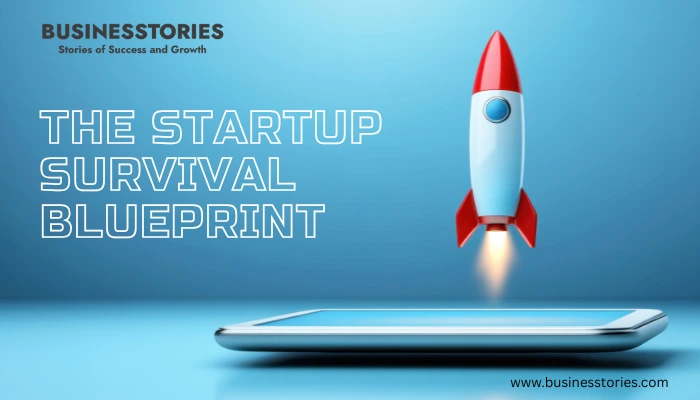Introduction: The New Reality for Startups
In 2025, the startup world looks very different from the hyper-growth years of the early 2020s. The easy money era is over. Coming to startup survival, financial conditions have become high challenge for borrowers and investors. Venture capital is cautious, investors are demanding proof of profitability and founders are forced to rethink what “growth” really means for their businesses.
If 2023 was the year of the funding freeze, 2024 was the year of financial reality. And 2025? It’s the year of the lean, resilient founders who are smart with money and can handle tough times well.
But here’s the upside: some of the world’s best companies — Mail chimp, Basecamp, Shopify — were built during downturns. These examples demonstrate that difficult economic times can actually foster innovation and business growth. The founders who succeed today are the ones who master resourcefulness, focus, and customer obsession.
This is your 2025 Startup Survival Blueprint, provides practical steps regarding how to survive and grow stronger when funds are limited.
Also Read: 5 Startup Mistakes That Quietly Kill Growth and How to Fix Them Fast
1. Shift from “Growth at All Costs” to “Sustainable Profitability”
The companies are moving from focusing only on growth to building sustainable profits. This startup survival business strategy, emphasis now on long-term profitability rather than rapid expansion at any cost.
The old mantra was “move fast and break things.” The new one? “Grow smart and build things that last for a long time.”
When funding is scarce, the focus must shift from chasing vanity metrics (like downloads, sign-ups, or followers) to achieving cash flow stability.
Here’s how modern founder’s strategies are doing it:
Focus on repeatable revenue model: Subscription, retainer, and usage-based models are replacing one time sales.
Cut tools, not talent: Many startups saved 25–40% in expenses by consolidating software stacks — switching from 12 or more tools to 3–4 core systems.
Know your unit economics: Every founder should know their CAC (Customer Acquisition Cost), LTV (Lifetime Value), and payback period.
“Profitability isn’t an event — it’s a discipline,” says Emma Li, founder of Finwise. “Startups win only when know where every rupee is going.”
2. Bootstrap Like It’s a Superpower for Startup Survival
Bootstrapping was surely considered a constraint in earlier times. This approach was viewed as restricting business growth and development. As per current market conditions, this gives a competitive advantage in business success.
Why? Because founders who bootstrap learn to:
- Validate ideas faster.
- Build products that customers actually want to buy.
- Entrepreneurs should maintain their ownership control and avoid giving away too much equity. Avoid the dilution trap and stay in control.
A recent MicroConf survey found that 76% of profitable SaaS founders never raised external funding.
Practical Bootstrapping Tactics:
- Launch a paid beta: Don’t wait for perfection — test early with paying users. Only real customers can tell if the product works, not perfect planning.
- Pre-sell before you build: Use landing pages or waitlists to gauge real customer demand.
- Build in public: Share your progress transparently on LinkedIn or X platforms — it attracts customers and talented people to your business alike.
Case in point: ConvertKit (email marketing tool) the success went from $0 to $2M ARR (Annual Recurring Revenue) without any external funding. This bootstrapped approach shows how companies can achieve significant growth using their own resources. Founder Nathan Barry did it by being open about progress, focusing on niche creators, and reinvesting early profits back into the business instead of looking for investors.
3. Double Down on Customer Retention
In tough markets for startup, new leads are expensive — but existing customers are gold.
Three retention moves that matter:
Personalized on boarding: Early engagement can reduce churn by up to 40%. Proper initial engagement proves highly effective in keeping customers.
Regular feedback loops: Use short surveys or direct interviews to get regular feedback. This help you understand what customers think about your product or services. Customers actually feel happy when companies listen to them. They definitely want their voices to be heard and valued.
Tiered loyalty programs: Offer bonuses, discounts, or community access for repeat buyers. These programs definitely reward customers who buy more often.
“Retention is the new growth,” says HubSpot’s latest SME report. “Businesses that increased retention by 5% experienced profits increase of up to 95%.”
A loyal customer base isn’t just recurring revenue — it’s free marketing through referrals and social proof for startup survival.
4. Embrace Lean Innovation
When money is limited, innovation has to be smarter, not bigger.
Lean startups use this cycle:
Build → Measure → Learn → Repeat.
You actually build something first, then measure how it works, learn from what happens, and definitely repeat this process.
Instead of massive product launches, test small ideas with real users every week instead of launching big products.
Example:
A food-tech startup in Singapore tested a meal subscription service using just WhatsApp and Google Sheets before coding a single feature. Within 3 months, they had proof of concept — and paying customers.
Tools like Notion, Zapier, Glide, and Airtable let you create working prototypes in days, not months.
Framework:
- Identify your most critical assumption, which is the same as identifying your biggest guess.
- Design a cheap, fast test to validate it.
Measure response → iterate.
You measure the response and then do the same process again to improve it.
The result? Faster learning, lower risk, and higher adaptability — the exact qualities investors love.
5. Diversify Revenue Streams for Startup Survival
Companies should surely explore multiple income sources to reduce financial risks. Moreover, having various revenue channels helps businesses maintain stability during market fluctuations.
Relying on one product or client can be fatal in uncertain times. Smart founders build micro-revenue streams that help them to stabilize cash flow management.
For example:
- A SaaS founder can offer consulting services or sell templates for additional revenue.
- A D2C brand can add a subscription model to enhance its business approach.
- A freelancer can launch a digital course or toolkit to share their expertise.
These “side” revenues not only improve stability but also expand brand authority.
Serial entrepreneur Sahil Lavingia says “Multiple small cash flows beat one big uncertain one,” further reduce business risk.
6. Build a Community, Not Just a Customer Base
Businesses should surely focus on creating communities rather than merely gathering customers. This approach builds stronger relationships and long-term loyalty among people. When budgets shrink, community becomes your biggest growth engine.
Startups that engage customers in private Slack, WhatsApp, or Discord groups are creating strong brand support on a large scale.
One of the best startup survival examples:
- Notion grew through a creator community first, before running ads.
- Figma became a design ecosystem, not just a tool.
How to Build One:
- Create a space for your users to connect using Facebook Group, Slack, or Discord.
- Share insider updates, early releases, and stories with everyone.
- Reward ambassadors — make them part of your brand’s mission.
When communities lead the growth, companies keep more customers and reach only more people while building stronger loyalty – these three things are very important for startups in 2025.
Also Read: Easy Ways You Can Turn Business Without Investment Into Success
7. Redefine Success
The founders who’ll win in 2025 aren’t necessarily the ones with the biggest funding rounds — they’re the ones with who possess:
- Consistent revenue, helps businesses plan better.
- Loyal teams, shows their work commitments.
- Sustainable business models, without harming the environment and society.
True success isn’t chasing valuation; but it is about getting freedom, flexibility, and sustainable growth.
Final Takeaway
Startups don’t die from lack of funding — they die from lack of focus.
One of the best step for startup survival, focus on customer value, working smart, and connecting with people, you will definitely not just survive but grow well.
The new generation of founders is proving one thing: Resilience is the ultimate startup growth hack.



